
As a teenager I used to play
OGRE and GEV, the quintessential
microgames produced by
Steve Jackson featuring cybernetic tanks called OGREs facing off with a variety of lesser tanks. For those that don't remember those "microgames", they were sold in small plastic bags or boxes, which contained a rulebook, map, and a set of perforated cardboard pieces used to play the game. After playing a lot, we extended OGRE by creating our own units and pieces from cut up paper; the lead miniature you see in the pictures came much later, and was not part of the original game.
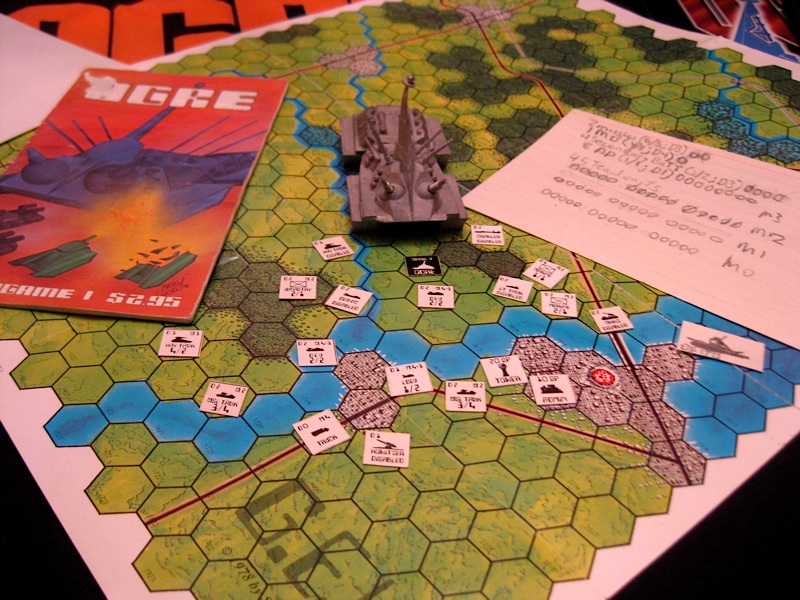
In OGRE's purest form, however, one
OGRE, a mammoth cybernetic vehicle, faced off with a dozen or so more other tanks firing tactical nuclear weapons ... and thanks to incredible firepower and meters of lightweight
BCP armor, it would just about be an even fight. Below you see a GEV (Ground Effect Vehicle) about to have a very bad day.
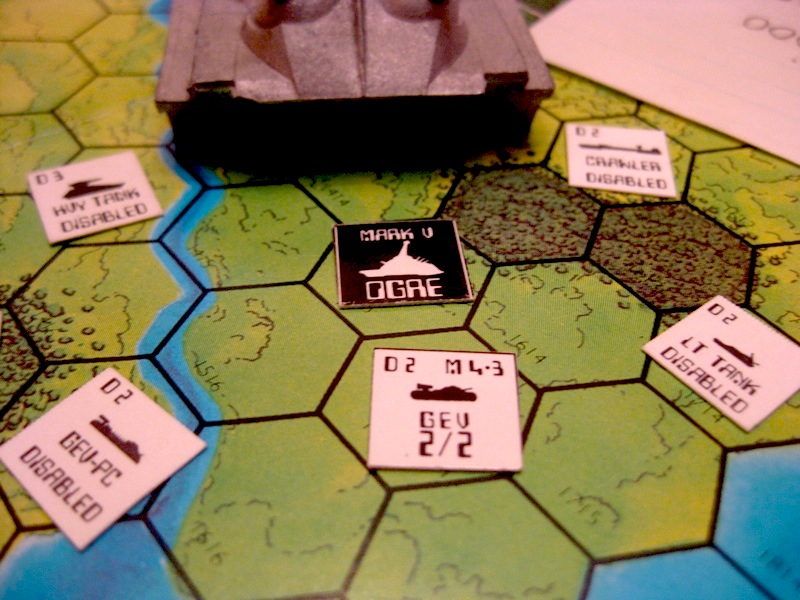
OGREs were based (in part) on the intelligent tanks from
Keith Laumer's
Bolo series, but there was also an OGRE
timeline that detailed the development of the armament and weapons that made tank battles make sense in the 21st century. So there was a special thrill playing OGRE: I got to relive my favorite Keith Laumer story, in which one decommissioned, radioactive OGRE is accidentally reawakened and digs its way out of its concrete tomb to continue the fight. (The touching redemption scene in which the tank is convinced not to lay waste to the countryside by its former commander were, sadly, left out of the game mechanics of Steve Jackson's initial design).
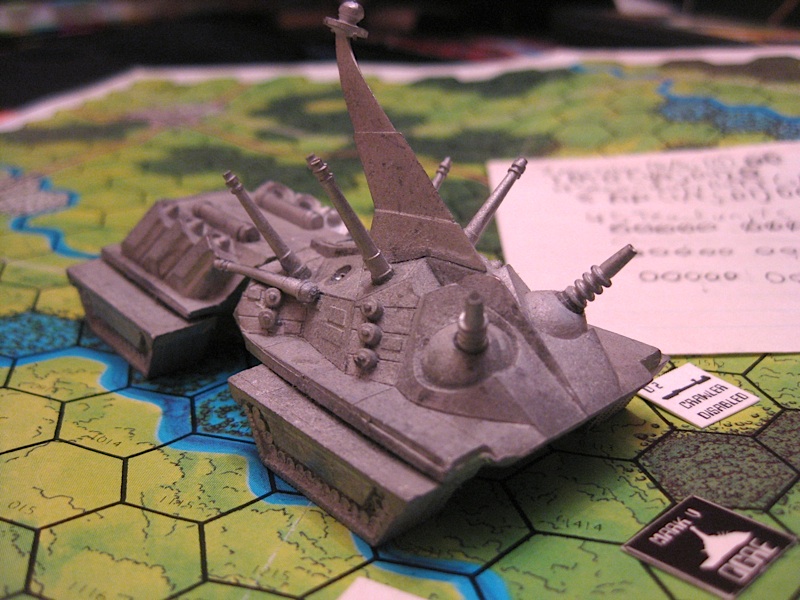
But how realistic are tales of cybernetic tanks?
AI is famous for overpromising and underdelivering: it's well nigh on 2010, and we don't have
HAL 9000, much less
the Terminator. But OGRE, being a boardgame, did not need to satisfy the desires of filmmakers to present a near-future people could relate to; so it did not compress the timeline to the point of unbelievability. According to the Steve Jackson OGRE chronology the
OGRE Mark I was supposed to come out in 2060. And from what I can see, that date is a little pessimistic. Take a look at this video from General Dynamics:
[youtube=http://www.youtube.com/watch?v=jCAiQyuWfOk]
It even has the distinctive OGRE high turret in the form of an
automated XM307 machine gun. Scary! Admittedly, the
XUV is a
remote controlled vehicle and not a completely automated battle tank capable of
deciding our fate in a millisecond. But that's not far in coming... General Dynamics is working on
autonomous vehicle navigation, and they're not alone. Take a look at
Stanley driving itself to the win of the
Darpa Grand Challenge:
[youtube=http://www.youtube.com/watch?v=LZ3bbHTsOL4]
Now, that's more like it! Soon, I will be able to relive the boardgames my youth in real life ... running from an automated tank ... hell-bent on destroying the entire countryside ...
Hm.
Somehow, that doesn't sound so appealing. I have an idea! Instead of building killer death-bots, why don't we try building some of
these instead (full disclosure: I've worked in robotic pet research):
[youtube=http://www.youtube.com/watch?v=NKAeihiy5Ck]
Oh, wait. The AIBO program was canceled ... as was the XM307. Stupid economics. It's supposed to be
John Connor saving us from the robot apocalypse, not
Paul Krugman and
Greg Mankiw.
-the Centaur
Pictured: Various shots of OGRE T-shirt, book, rules, pieces, and miniatures, along with the re-released version of the OGRE and GEV games. Videos courtesy Youtube.
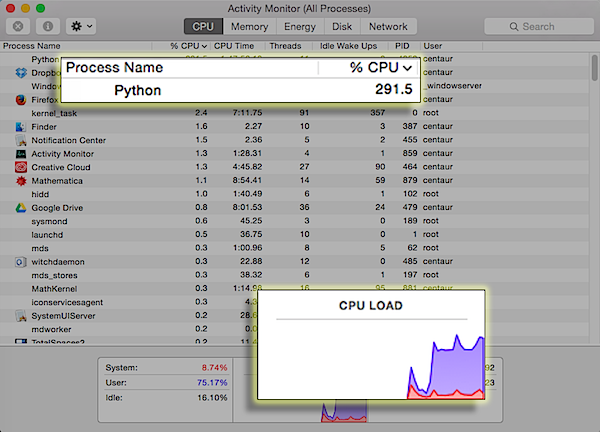 Yep, that’s Python consuming almost 300% of my CPU - guess what, I guess that means this machine has four processing cores, since I saw it hit over 300% - running the TensorFlow tutorial. For those that don’t know, "deep learning” is a relatively recent type of learning which uses improvements in both processing power and learning algorithms to train learning networks that can have dozens or hundreds of layers - sometimes as many layers as neural networks in the 1980’s and 1990’s had nodes.
For those that don’t know even that, neural networks are graphs of simple nodes that mimic brain structures, and you can train them with data that contains both the question and the answer. With enough internal layers, neural networks can learn almost anything, but they require a lot of training data and a lot of computing power. Well, now we’ve got lots and lots of data, and with more computing power, you’d expect we’d be able to train larger networks - but the first real trick was discovering mathematical tricks that keep the learning signal strong deep, deep within the networks.
The second real trick was wrapping all this amazing code in a clean software architecture that enables anyone to run the software anywhere. TensorFlow is one of the most recent of these frameworks - it’s Google’s attempt to package up the deep learning technology it uses internally so that everyone in the world can use it - and it’s open source, so you can download and install it on most computers and try out the tutorial at home. The CPU-baking example you see running here, however, is not the simpler tutorial, but a test program that runs a full deep neural network. Let’s see how it did:
Yep, that’s Python consuming almost 300% of my CPU - guess what, I guess that means this machine has four processing cores, since I saw it hit over 300% - running the TensorFlow tutorial. For those that don’t know, "deep learning” is a relatively recent type of learning which uses improvements in both processing power and learning algorithms to train learning networks that can have dozens or hundreds of layers - sometimes as many layers as neural networks in the 1980’s and 1990’s had nodes.
For those that don’t know even that, neural networks are graphs of simple nodes that mimic brain structures, and you can train them with data that contains both the question and the answer. With enough internal layers, neural networks can learn almost anything, but they require a lot of training data and a lot of computing power. Well, now we’ve got lots and lots of data, and with more computing power, you’d expect we’d be able to train larger networks - but the first real trick was discovering mathematical tricks that keep the learning signal strong deep, deep within the networks.
The second real trick was wrapping all this amazing code in a clean software architecture that enables anyone to run the software anywhere. TensorFlow is one of the most recent of these frameworks - it’s Google’s attempt to package up the deep learning technology it uses internally so that everyone in the world can use it - and it’s open source, so you can download and install it on most computers and try out the tutorial at home. The CPU-baking example you see running here, however, is not the simpler tutorial, but a test program that runs a full deep neural network. Let’s see how it did:
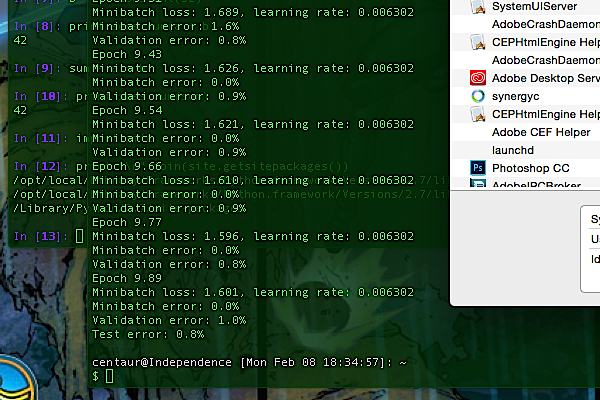 Well. 99.2% correct, it seems. Not bad for a couple hundred lines of code, half of which is loading the test data - and yeah, that program depends on 200+ files worth of Python that the TensorFlow installation loaded onto my MacBook Air, not to mention all the libraries that the TensorFlow Python installation depends on in turn …
But I still loaded it onto a MacBook Air, and it ran perfectly.
Amazing what you can do with computers these days.
-the Centaur
Well. 99.2% correct, it seems. Not bad for a couple hundred lines of code, half of which is loading the test data - and yeah, that program depends on 200+ files worth of Python that the TensorFlow installation loaded onto my MacBook Air, not to mention all the libraries that the TensorFlow Python installation depends on in turn …
But I still loaded it onto a MacBook Air, and it ran perfectly.
Amazing what you can do with computers these days.
-the Centaur 


